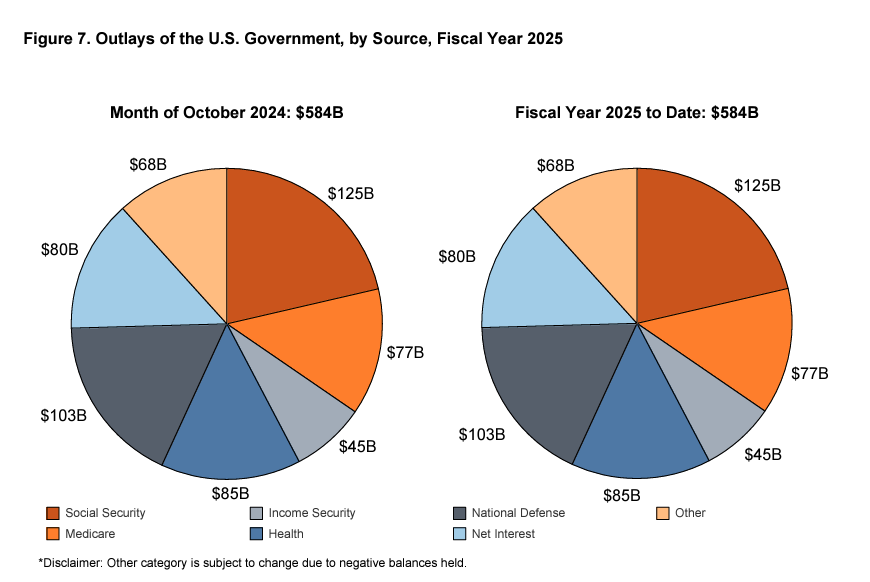After running the third-largest budget deficit in history in fiscal 2024, the Biden administration kicked off fiscal 2025 in an identical manner.
The federal government ran a $257.45 billion budget shortfall to start out the brand new fiscal 12 months, with revenue down and spending up, in line with the most recent statement from the Department of Treasury.
That was a 287 percent increase over the October 2023 deficit.
Federal receipts got here in at $326.77 billion. That was down about 19 percent in comparison with October 2023. A one-time influx of tax payments deferred resulting from wildfires last 12 months boosted October 2023 revenues.
As has been the case for months, the large problem is on the spending side of the ledger.
The Biden administration blew through $584.22 billion last month. That was a 24 percent year-on-year increase. Outlays for Social Security, Medicare, and national defense all increased.

You may recall that President Biden promised that the [pretend] spending cuts would save “tons of of billions” with the debt ceiling deal (aka the [misnamed] Fiscal Responsibility Act).
That never happened.
The federal government continues to seek out recent reasons to spend money, whether for natural disasters at home or wars overseas. The Biden administration spent a staggering $6.75 trillion in fiscal 2024, a ten percent increase over 2023 outlays.
The federal government spent $82 billion on interest expenses last month. That was a modest 8 percent decline, the primary annual drop in interest expense since August 2023. The Treasury Department said the decline was driven by a $12 billion reduction in payouts for inflation-protected securities due to a lower CPI.
Net interest expense got here in at $80 billion. That was a $4 billion increase over October 2023.
Uncle Sam paid $1.13 trillion in interest expense in fiscal 2023. It was the primary time interest expense has ever eclipsed $1 trillion.
Interest payments were up 28.6 percent over fiscal 2023 levels.
Don’t let the small decline in interest expense last month idiot you. The overall trend stays upward. Even with the recent Federal Reserve rate cuts, Treasury yields are pushing upward as demand for U.S. debt sags. Since Trump’s electoral victory, the yield on the 10-year Treasury is up 15 basis points.
Much of the debt currently on the books was financed at very low rates before the Federal Reserve began its mountaineering cycle. Every month, a few of that super-low-yielding paper matures and has to get replaced by bonds yielding much higher rates.
Impact of the Debt
We see these big deficits month after month, but most individuals don’t bat a watch. There appears to be a way that spending greater than you are taking in month after month isn’t really an issue.
But anybody who says “deficits don’t matter” is deluded.
Because the Bipartisan Policy Center points out, the growing national debt and the mounting fiscal irresponsibility undermine the dollar.
“Confidence in U.S. creditworthiness could also be undermined by a rapidly deteriorating fiscal situation, an increasing concern with federal debt set to grow substantially in the approaching years.”
This may lead to lower economic growth, higher unemployment, and fewer investment wealth.
Insecurity within the U.S. fiscal situation could also lower demand for U.S. debt. This may force rates of interest on U.S. Treasuries even higher to draw investors, exacerbating the interest payment problem.
The national debt continues to spiral upward at a dizzying pace. It’s going to officially top $36 trillion inside days. In response to the national debt clock, that represents 122.85 percent of GDP. Studies have shown a debt-to-GDP ratio of over 90 percent retards economic growth by about 30 percent.
The debt will likely be considered one of the most important problems facing President Trump as he takes the reins of power. With Republicans controlling each chambers of Congress and the White House, there may be a chance to tackle the spending problem, but whether the GOP has the political will to make substantial cuts stays to be seen.